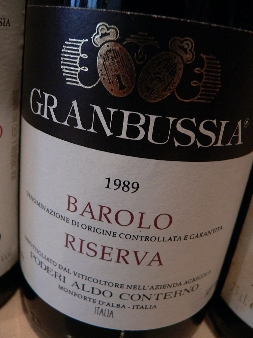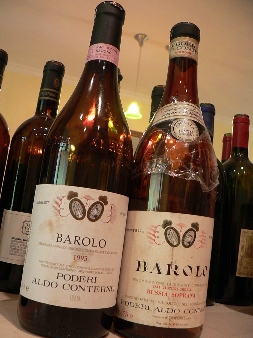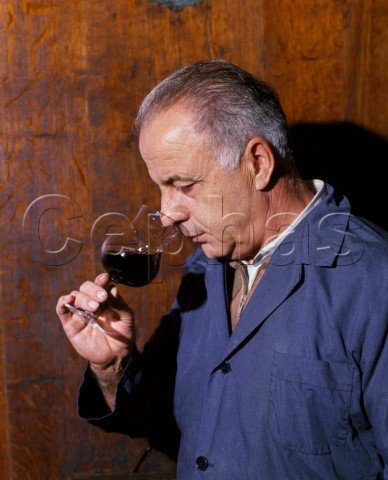Views: 92
如果你像 Tom Hanks 在電影 Cast Away 《劫後重生》中那樣落難在孤島上,而讓你只帶一瓶酒,你會選哪一瓶?
多年前我看《華爾街日報》夫妻檔酒評人 Dorothy Gaiter 與 John Brecher 的一篇文章,便是以此開始。他們兩只聳一聳肩,便同時回答﹕Barolo !
這是我迷上 Barolo 的開始。
今天如果有人問我同一個問題,我會不用思索的回答﹕Granbussia!
好的 Barolo 如天上星星,但往往太 challenging 與 intellectual ,幾乎都要正襟危坐上半天才能一窺其風采。
Aldo Conterno 的 Granbussia 是少有的例外。

這瓶 1989 Granbussia 一開瓶已經有香氣涌出。Barolo 的泥土、蘑菇、松茸、玫瑰花等等香味,應有盡有。酒體很有分量而非重量( volume, not weight ),鮮甜而有活力,甜與細的丹寧包著紅漿果,是味道的極致!驚人的是﹕持續了大半天,到最後一滴還是那麼美味!

Granbussia 是 Aldo Conterno 的頂級酒。其後,我們再開了兩瓶他們的入門 Barolo : 1978 與 1995 Bussia Soprana ,發現他們是同一個模子長出來的,少了幾分複雜性,但同樣是平易近人,散發著 Monforte 大地的芳香,令我想起 Dvorak!

Aldo Conterno 照片來源﹕www.cephas.com
Aldo Conterno 是 Giacomo Conterno 的兒子,Giacomo 在 1961 年把酒莊傳給 Giovanni 與 Aldo 兩兄弟掌管,但到了 1969 年, Aldo 決定離開父業,在 Monforte 村的 Bussia 買地另起爐灶。兄長 Giovanni 留在 Giacomo Conterno 酒莊,繼續釀造最最傳統的 Barolo ,之後傳給 Roberto ,依然是傳統的堡壘。
根據 Aldo Conterno 的網站,他之所以離家自立,是要完成他年青時代的夢想。 Aldo 二十幾歲時曾遠赴美國加州,在那裏待了五年之久。他原來希望憑他一位叔叔的幫助發展葡萄酒的業務,但卻沒有成功。回國差不多十年後終于有機會成立自己的酒莊。
但我看真正的原因應該是他的釀酒哲學不同!
Aldo Conterno 的網站說他們的信條是 “in medio stat virtus” (拉丁語,意為Virtue stands in the middle ),我們儒家的所謂「中庸之道」也!
他父親 Giacomo Conterno 的 Monfortino ,一直奉行著最傳統的釀制法﹕極長時間在沒有控制氣溫的情況下浸泡葡萄,然後極長時間在舊木桶中發酵。這是鋌而走險的做法,酒要陳年多年才可以享用,但日子久了,酒質能保存多少還是未知之數。 Sheldon Wasserman 大力推許 Giacomo Conterno ,但也不得不指出﹕
Like some of the other Barolos that are given long cask aging, Conterno’s wines seem to be more susceptible to damage by improper handling or storage. While we’ve had many magnificent Barolos from Giovanni Conterno, we’ve had some that didn’t measure up, which were in fact disappointments. We are convinced, however, that the problem occurred after the wines left the winery.
所以 Aldo Conterno 覺得有革新的必要。他可能是傳統酒莊中最注重衛生的。他的兒子Franco 在一次訪問中曾說﹕
“Our father always remarked how well wines aged in larger formats. He wanted to preserve as much of that freshness as possible by leaving the wine for two years in steel prior to bottling. Above all else he was concerned with cleanliness, a value he instilled in us early on. We age our Barolos exclusively in large Slavonian oak casks. One of our challenges is keeping the barrels perfectly clean, so each year we recondition the casks by scraping out the part of the oak that has been in contact with the wine.”

Aldo Conterno 與 Angelo Gaja 同樣于 1961 年加入家族酒莊。 Aldo 選擇了改良的路,但 Angelo 更進一步,他的大刀闊斧改革使他成為「現代派」的頭號人物(之後才出現像 Altare 、 Voerzio 、 Clerico 這些所謂「現代派」 )。
在以前的一篇網誌裏,我曾經問過﹕傳統好還是現代好?(見﹕Piedmont 交響曲)
今天我要問﹕改良好還是改革好?
從一瓶酒也可以看天下!



附錄一 Landmark Wines of Italy, from Italian Wine Merchants website
http://www.italianwinemerchantstore.com/investing/landmark_wines/a_conterno_granbussia.html
Aldo Conterno Barolo Granbussia Riserva:
[ahl-do kon-tehr-no g(l)rahn-boos-syah(l)]
Barolo Granbussia Riserva is the most traditional of Aldo Conterno’s offerings and vies with his late brother’s Barolo Monfortino Riserva for positioning as Italy’s most significant Barolo. Though Aldo’s style of winemaking is by no means modern, a comparison to his brother’s Monfortino illustrates the direction in which Barolo is progressing. Aldo Conterno is regarded as the “King of Barolo” for his rare and elusive ability to strike a balance between traditional and modern orientations, applying technology in a manner that supports the retention of Nebbiolo’s character while crafting wine with a broader appeal.
The 1970 debut bottling was sourced from grapes in the Colonnello and Cicala vineyards in the commune of Monforte d’Alba; Conterno altered the composition significantly with the 1985 vintage, introducing the Romirasco vineyard as the primary, defining source (70 percent) and reducing the contribution of the Colonnello and Cicala vineyards (15 percent each). While this remains the general blending formula, the nuances of a given vintage are recognized and articulated through appropriate alterations.
After the individual sources are fermented and aged for a period of 32 to 36 months in traditional Slavonian oak, the components are assembled and aged for an additional year and a half or two. The maturation period (in both cask and bottle) comprises six years in total; thus, it is unique among the wines of its designation, being released one year after its fellow Barolos of the vintage.
The Cicala Vineyard is situated on concave slopes that range in aspect from south to southwest and are sheltered from hazardous winds. Grapes benefit here from a clay-based soil that offers lime and calcium carbonate, generating a bold, ageworthy wine that is tempered by the attributes of the Colonnello and Romirasco sites. The sandy soil and younger vines of the Romirasco Vineyard provide for softness and elegance, as does the similar but more proportioned Colonnello, which combines the balance and refinement of wines from the Barolo subzone with the weight and structure of those from Serralunga.
This wine is produced exclusively in the best vintages. It is significant to note that Conterno made Granbussia only eight times between 1971 and 1994.

附錄二 History and Philosophy of Aldo Conterno winery, from producer website
http://www.poderialdoconterno.com/getcontent.aspx?nID=22&l=en
The History
In the 19th century, the forefathers of Aldo Conterno emigrated to Argentina , but on account of various family vicissitudes they returned to Italy after a few years. It was then that Giovanni Conterno brought his family back to the small winemaking farm of his father Giuseppe in Monforte d’Alba and started helping him in the production of local wine. With his return to the business, Conterno increased the production of wine, to be sold in casks not only in Piemonte and Liguria but also as far as America , thanks to a relative who had stayed out in Argentina . In response to market demand, the Conternos then felt the need to create a superior Barolo, to be produced exclusively from the best vintages, with a long VINIFICATION period and capable of lasting over time. In the 1920s the first Barolo reserve was bottled. At the end of the ’30s Giovanni handed over the reins of the business to his son, Giacomo, who continued his father’s tradition with commitment and foresight, visiting his clients in person and taking advantage of the prestige which Barolo was gathering to establish his own label in many regions of Italy . During these years, his sons Giovanni and Aldo began to assist and follow their father in running the business. In the mid-’50s Aldo decided to set out for America , with the ambition of creating a vine-growing and winemaking business with the help of an uncle who lived in California . This period in the United States turned out to be very constructive and unforgettable for Aldo but for a variety of reasons he had to abandon the country and come back home to his family business in Italy . Giacomo handed over the activity to his sons in 1961: it was a thriving and prestigious business in the Langhe zone, recognised over most of the country.
However, the five-year experience in the United States had kindled within Aldo a desire to establish a business of his own. It was for this reason that he decided, after working for a considerable time alongside his brother, to carry out the dream which had been interrupted in America . He bought the “Favot” farm and founded the estate “Poderi Aldo Conterno” in 1969.
The Philosophy
Our family represents the heart of all our activities.
Five generations of people who devoted their lives to wine have instilled in our souls a deep respect for the identity of our territory and a firm characterization of our products.
What we want to offer is simply the interpretation of a ground through our deep rooted beliefs, by trying to mediate and to mix tradition with innovation, according to the Latin saying “in medio stat virtus”.
Our wines never look for inconditional approval and our personality is not prone to easy compromise.

附錄三 Antonio Galloni’s article on eRobertparker.com website
Aldo Conterno 2001 Vintage
July, 2005
Consumers who enjoy the wines of Aldo Conterno would do well to pick up this estate’s excellent 2001s. This perfectionist producer has bottled none of his 2002s and will release only a few of his 2003s including a single bottling of Barolo. “2003 was just too hot. When temperatures go above 35 degrees Celsius (95 degrees Farenheit) without respite, the plants shut down and the seeds don’t ripen fully. If the fruit is harvested too soon, the wines retain these green, hard tannins which can be quite unpleasant,” explains Giacomo Conterno, Aldo’s son. Turning more upbeat, Conterno says “I do think 2004 has all the ingredients to be a great year.”
“In my opinion, it should be possible to tell if a wine is balanced and well-made as soon as it is in the bottle,” says Conterno. “Of course a young Barolo will be tannic, and in need of bottle age to reach its maximum expression, but the idea that a Barolo should be tough and inaccessible when young, and need 30 years to reach greatness is absurd. I want to make Barolos that will be delicious after 4-5 years, and that will continue to improve for decades after that.”
In terms of winemaking, the house style is divided along two lines. “When it comes to Barolo we have been traditionalists for five generations. We try to interfere as little as possible in the cellar in order to exalt the differences in the terroirs we work with,” explains Conterno. The estate’s four Barolos are vinified in the same manner. The wines are fermented in horizontal fermenters, “which are different from the more violent rotary fermenters explains Conterno. Fermentation and maceration lasts 2-3 weeks, depending on the vintage. The wines are then aged in Slavonian oak casks ranging from 25 to 75 hectoliters, which are changed every 15-18 years. Selected yeasts are not used. The wines are very approachable, even in a structured vintage such as 2001, and tend to show a lot of sweet fruit in their youths as well as notes of spices and vanilla that suggest at least some new oak. These are very clean and polished wines of great elegance. A distinctly more modern approach is taken with the other wines, such as the Chardonnay Bussiador, Langhe Favot and Langhe Quartetto, all of which are aged in 100% new barriques and come across as quite contemporary.



Dear 心兄,
Would you recommend any vintages of Bussia soprana? I supposed you would say Gran Bussia are exceptional for all vintages available…..
There are some offerings of 97 Gran Bussia at 2K/bottle from FRW.
[版主回覆01/03/2010 09:29:00]Altaya Wines has '82, '95, '00 and '01 Granbussia on offer at very good prices. Their '00 is only $1,650! Suggest you get the '95 at $1,360, for a few more years of bottle age. They also have a good selection of Giacosa! http://www.altayawines.com/en/home.php
For Bussia Soprana, try to get one from the '90s. Just avoid '91-'94. I have a blog on Italian vintages:
http://hk.myblog.yahoo.com/jw!KluzXNGFHxnw1caKUQ.uq3gVlA–/article?mid=2266
Thanks!
[版主回覆01/04/2010 21:09:00]You might like to get hold of a 2004 Romirasco too. I think Italian Wine Merchants has got this.
http://www.iwm.com.hk/
I ve been drinking a recent vintage of Romirasco and enjoyed immensely the explosive bouquet when the cork was pulled out. There was mint, eucalyptus (I m not sure cos I was the only one drinking ) very sweet and soothing first impression. It blew me off completely!!
[版主回覆01/04/2010 21:05:00]The 2004 amazed me too for its exuberance, quite rare for such a young Barolo. It was in a previous blog:
http://hk.myblog.yahoo.com/jw!KluzXNGFHxnw1caKUQ.uq3gVlA–/article?mid=2890
The only previous vintage was 1993, as it used to be part of the Granbussia blend, and never released as a single cru, not until 2004!
Honestly, Romirasco is already beyond expectation. I thought I was on drug to experience that bouquet. But that first impression perhaps lingered for the first thirty minutes and it was not there any more. It moved on to something else which I cannot say I enjoy as much. Oh, I miss that first encounter…. I almost open the next bottle just to revisit that precious moment.
[版主回覆01/04/2010 22:57:00]I remember that too, and that also happened with a 2004 Siro Pacenti Brunello that I tasted several months ago. Also a new wine, and the first 5-10 minutes could kill anyone. A kind of "irrational exuberance"?
There are bussia soprana on offering at FRW, from 82 and 88.
http://www.frw.co.uk/search-wines-smart-search_page-1-keywords-bussia%20soprana-sid-4.aspx
[版主回覆01/04/2010 22:52:00]Both are expensive. You get more from a lesser vintage Granbussia, which is from 3 choice crus.
The '95 Bussia Soprana is good value.
just got the gran bussia and bruno giacosa from altaya, rather efficient service!
Will try to secure romirasco 04 from FRW. Pretty good price. Thanks!
[版主回覆01/05/2010 23:46:00]That's good! Would love to hear what you think of them.
Dear 心兄,
I started drinking wines less than 2 yrs ago. I have been reading your excellent aricles for the past 6 months. Thank you very much for sharing so many wonderful experiences. Your informative articles and the book "Vino Italiano" have drawn me deeply into the world of Italian wines.
In the above articles, you mentioned a number vintages of Aldo Conterno but 1996. I would like to consult your opinion on Granbussia 1996. Thanks.
[版主回覆04/01/2011 15:55:00]
Thanks for your interest. 1996 is widely regarded as the best vintage since 1989, which means it probably takes a lot more than the normal 20 years to mature. That's why I did not have the courage to touch it. I have been preparing myself for this big lesson, and perhaps I should start some day soon. Will certainly report my findings when I'm done.
Would love to hear your experience if you ever have a chance to try Granbussia or any 1996.
p.s.: I became a serious drinker of Italian wine only about 2 years ago, and 2 years is a pretty long time if we let the wine consume us. Hope you'll have an exciting journey!
Thanks, 心兄. I just ordered 3 Gran Bussia 1996 from Italy for 110 Euro each. Compared with the price of other vintages here at Taipei, this seems to be a good price.
[版主回覆04/08/2011 13:35:00]Great deal while the Euro is still not too high. I'm at a total loss why this is so greatly under-priced.